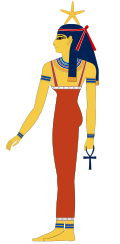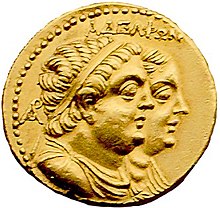Book of Sothis
The "Book of Sothis " (also pseudo-Manetho ) is an alleged work by Manetho , which Georgios Synkellos translated at the end of the eighth century AD. It is mainly based on the information provided by Flavius Josephus and Eusebius of Caesarea and was dated by Alfred von Gutschmid to the end of the third century AD. Some of the names listed in the “Book of Sothis” are taken from other sources, as, among other things, terms are used that do not appear in the Manethonic versions.
The unknown author gave the dynastic duration of the ancient Egyptian kingship at 2211 years, during which a total of 86 kings are said to have ruled. The “Book of Sothis” ends with the report on Cambyses II , founder of the 27th Dynasty , “of Egypt by force of arms in 4987 Annus Mundi (523 BC) during the reign of Amasis , the 86th king ( Pharaoh ), conquered “.
Historical meaning
Georgios Synkellos reports that the "Book of Sothis" was intended as a dedication of "Manetho from Sebennytos " to the pharaoh Ptolemy II (285–246 BC), because Ptolemy II wanted to learn to look into the future. Manetho is said to have translated the "Book of Sothis" for him, based on the sacred books of Thoth , which were written in sacred language on monuments .
After closer examination, this accompanying work from the history of Ancient Egypt turned out to be a forgery. However, the unknown author had a good knowledge of Manetho. The clearest indication of forgery can be seen in the introduction to the dedication to Ptolemy II , who was named by the author as "Σεβαστω ( Augustus )", a title that was only used in the first century BC. Was introduced:
“For the great King Ptolemy Philadelphos Augustus. Greetings to my Lord Ptolemaios, from Manetho, high priest and scribe of the sacred Egyptian shrines , born in Sebennytos and living in Heliopolis . It was my job, O greatest King, to ponder everything that you wished to investigate. Ever since you tried to fathom the future of the universe , see, I obediently obeyed your command. Everything is written down in the books of your forefather Hermes Trismegistus . I pray that the king, sir, may live well. "
Nevertheless, the “Book of Sothis” is another important work with regard to the Manetho writings, even if the information given there is an attempt to connect the events in the Old Testament with ancient Egyptian history in a non-historical-chronological form. Chronology critics such as Immanuel Velikovsky nevertheless used the information from the "Book of Sothis" as basic data in their works.
content
The "Book of Sothis" begins "534 years after the biblical flood (3268 BC) in Annus Mundi 2776 (2734 BC)" with the ancient Egyptian king ( Pharaoh ) Menes . It lists the Greek names of the ancient Egyptian kings in chronological order and names the associated government dates, sometimes with notes on special events of individual kings. The first 25 kings are said to have ruled a total of 700 years before the Hyksos ruler " Silitês " is listed as the 26th king "in the year Annus Mundi 3476 (2034 BC)".
In addition, the following topics are dealt with: “ Sothis cycle ” and its historical use, the dating of the introduction of the Egyptian calendar with 365 days, the conversion of “divine years” into “royal earth years” and the “Egyptian stay of Abraham and Joseph ”. In contrast to the other Manethonic versions by Josephus , Africanus and Eusebius , the Exodus from Egypt under Moses is not mentioned.
See also
literature
- Gerald P. Verbrugghe, John M. Wickersham: Berossos and Manetho, introduced and translated. Native traditions in ancient Mesopotamia and Egypt. University of Michigan Press, Ann Arbor MI 2000, ISBN 0-472-08687-1 .
- William Gillian Waddell: Manetho (= The Loeb classical library. Vol. 350). Heinemann et al., London 1940, digitized . Reprint: Harvard University. Press et al., Cambridge MA 2004, ISBN 0-674-99385-3 .

